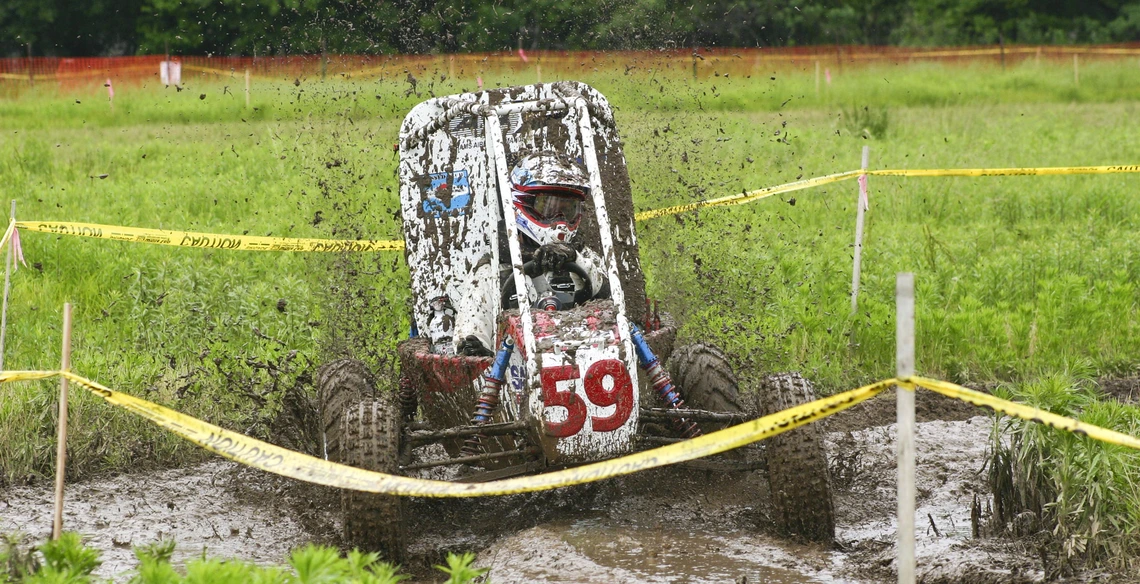UA Baja Racing Gives Best Performance in Club History at International Competition
UA team shows race-hardened engineering expertise this year with a solid performance against the experienced international field.

Got mud? The UA Baja Racing off-road racecar powers through the mud at the SAE Collegiate Design Series race meet at Pittsburg State University campus in May 2011.
UA Baja Racing placed 21st out of a field of 100 teams in the 2011 international collegiate off-road racing competition, a personal best for the student engineering club.
One hundred student teams from the US, Brazil, Canada, France, Mexico, Argentina, Israel, and India converged on the Pittsburg State University campus in Kansas in May 2011 to compete in the Baja SAE Collegiate Design Series, organized by the Society of Automotive Engineers.
The last few years have seen the UA Engineering club climb steadily up the rankings. The team ascended from the back 20 in 2007 to come in 33rd in 2008 and 2009, but wrecks and mechanical problems pushed them back to 52nd and 53rd in 2010, when they entered two cars.
Tough Build
The UA team showed race-hardened engineering expertise this year with a solid performance against the experienced international field. UA Baja Racing's overall score was 668 points out of a possible 1000.
"We built a really solid car this year," said Josh Spivey, who graduated in May 2011 in mechanical engineering and recently stepped down as UA Baja Racing club president. Spivey's senior design project, which he and his design team presented at Engineering Design Day in May 2011, was building a drive train for the Baja racecar.
Achieving the highest finishing position in the club's history means that Spivey hands over the reins on a high note, but he knows there is still work to be done. "We've got the build down," Spivey said. "Now it's about squeezing every last bit of horsepower out of the engine."
Managing that task will fall to Spivey's replacement as club president, civil engineering junior Sean Hays. "We are going to build on what we have learned," Hays said. "We will do more testing, refine the transmission, and carefully measure the car's performance."
Mud and Penalties
The trick to placing well in this competition is to put in a robust performance in every category without incurring penalty points, which is exactly what the UA team did this year, and hopes to do next. In the static events of cost and design reports and presentations, the team scored 207 out of 300, with their design report drawing a noteworthy 158 out of 200 from the judges.
The story was the same in the dynamic events, which test acceleration, maneuverability, pulling power, suspension and traction, and, of course, driving ability. UA Baja Racing completed every event and scored 180 out of 300 available points, including an impressive 61 out of 75 for maneuverability, the 4th best score in that event.
The final event, the endurance race, is an epic test of every aspect of the car's design and driver's ability, and carries fully 40 percent of the overall points available. UA tackled the demanding course to finish 22nd in this event with 281 points out of a maximum of 400.
The UA car faced an unexpectedly tough obstacle in the endurance event -- mud. The days preceding the race saw the area's worst weather in 60 years. "I have never seen mud like that," said Spivey, who was one of the drivers during the race. "It was power-robbing and we were lucky we did not get stuck." Hays concurred: "There was probably a hundred pounds of mud on the car by the end of the race," he said.
Baja SAE, organized by the Society of Automotive Engineers, consists of regional competitions that simulate real-world engineering design projects and their related challenges. The idea behind the competition is to prepare team members for work in the real world and its rules and regulations, deadlines and goals.
UA Baja Racing designs new vehicles every year and competes in the Baja SAE Collegiate Design Series every summer. Teams must design, build, market and race a single-seat off-road vehicle while securing financial support for their vehicles and keeping up educational priorities.

